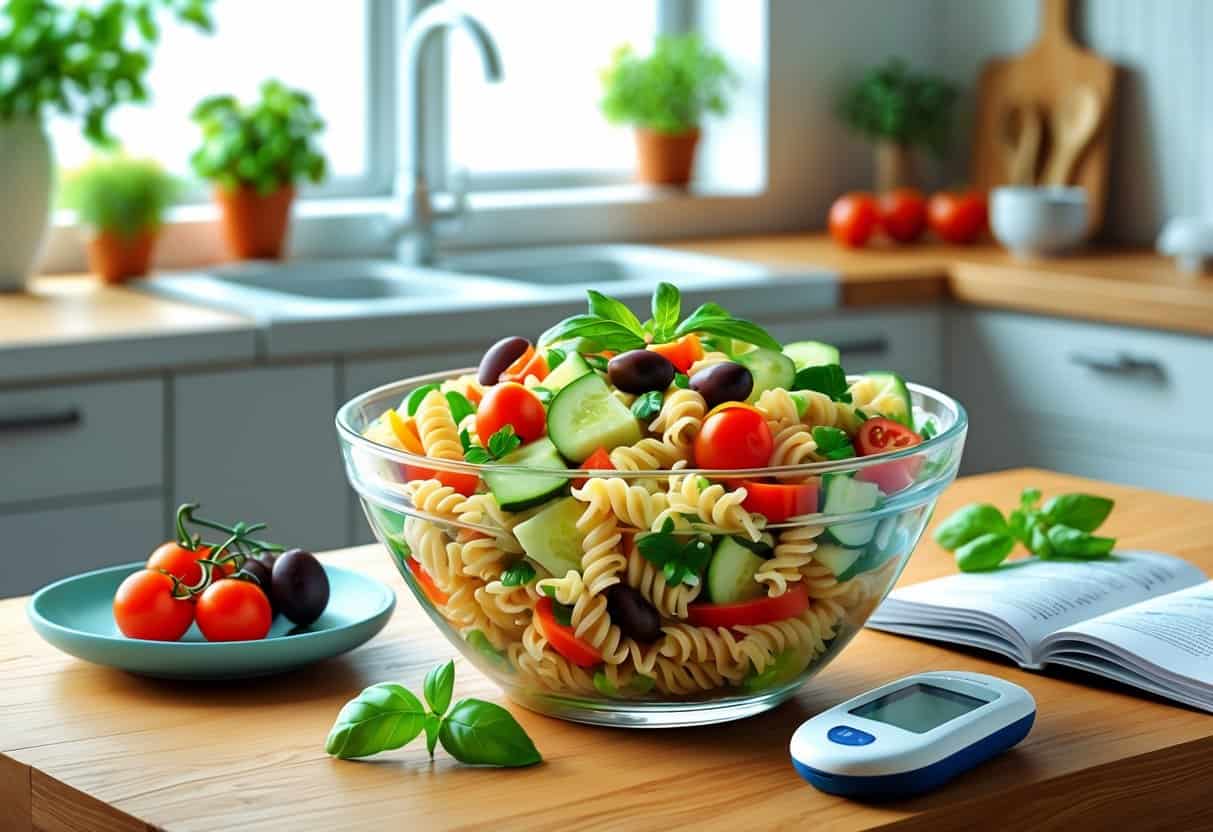If you have diabetes and love pasta, you might be asking yourself if cold pasta salad is okay for your diet. Cold pasta salad can be a safe pick for diabetics, especially if you make it with whole wheat pasta and toss in lots of fiber-rich veggies and lean proteins.
This combo helps control blood sugar while still letting you enjoy a flavorful meal.

Eating pasta cold might even offer some perks because the starch changes after cooling, possibly lowering its blood sugar impact. Picking the right ingredients and watching your portions are pretty important if you want your pasta salad to be a healthy choice.
You’ll find out which ingredients work best and how to make cold pasta salad fit into your diabetes plan. That way, you can enjoy a fresh, tasty dish without stressing about blood sugar spikes.
Key Takeways
- Whole wheat pasta helps reduce blood sugar spikes.
- Adding vegetables and lean proteins improves blood sugar control.
- Cooling pasta changes starch and can make it easier to manage.
Health Impacts of Cold Pasta Salad for Diabetics
Cold pasta salad can affect your blood sugar and overall health depending on the type of pasta and how you prepare it. Picking the right pasta and knowing how it impacts your body matters for diabetes management.
Effect on Blood Sugar Levels
Eating cold pasta salad can slow the rise of blood sugar after meals. When pasta cools, it forms resistant starch.
Resistant starch is tougher to digest, so sugar enters your bloodstream more slowly. This can help you feel full longer and might reduce hunger between meals.
If you’re managing diabetes, that slower rise can mean better blood sugar control. Still, keep an eye on portion size and what you toss in—high-sugar dressings or carb-heavy sides can mess things up.
Role of Whole Grains and Pasta Types
Whole wheat pasta is a better pick for cold pasta salad. It’s got more fiber than regular semolina pasta, and fiber slows down digestion and blood sugar spikes.
Types like whole-wheat rotini tend to keep blood sugar more steady than white pasta. Fiber’s also good for your gut and helps you stay full.
Craving comfort food? Go for whole grains and add lean proteins or veggies. That way, your meal’s balanced and more diabetes-friendly.
| Pasta Type | Fiber Content | Effect on Blood Sugar |
|---|---|---|
| Whole Wheat Pasta | High | Slower blood sugar rise |
| Semolina (White) Pasta | Low | Faster blood sugar rise |
| Cold Pasta (any type) | Resistant Starch forms | Slows digestion and sugar absorption |
Ingredients and Their Influence on Glycemic Response
The ingredients you pick for cold pasta salad really shape how your blood sugar reacts. Fiber-rich veggies and quality dressings can help keep things steady.
Choosing Fiber-Rich and Low-Carb Ingredients
Including fiber is key to slowing down glucose absorption. Veggies like broccoli, cauliflower, spinach, kale, cucumber, tomato, and red onion add fiber and nutrients without loading up on carbs.
Leafy greens such as basil and mixed vegetables bump up the fiber and bring more flavor. Chopped walnuts add healthy fats and protein, which can help reduce blood sugar spikes.
Whole grain or legume-based pasta is a smarter choice than regular pasta. It’s lower on the glycemic index, so your blood sugar rises more slowly.
Impact of Dressings on Diabetes Management
Dressings made with olive oil, vinegar, and lemon juice can help with blood sugar control. Olive oil has healthy fats that slow digestion and blunt blood glucose spikes.
Vinegar and lemon juice add acidity, which might lower the glycemic index of your meal. It’s best to skip dressings loaded with sugar or sweeteners.
Season your salad simply with kosher salt, black pepper, and garlic for flavor without piling on extra carbs or sodium. This approach makes your salad more diabetes-friendly.
Nutrition and Recipe Modifications for Diabetics
You can make cold pasta salad healthier for diabetes by choosing ingredients that support blood sugar control. Small tweaks to the pasta, veggies, and prep can make a real difference.
Healthy Alternatives and Additions
Choose whole-wheat or whole-grain pasta over regular pasta. Whole grains have more fiber, which slows sugar absorption and keeps your blood sugar steadier.
Add plenty of non-starchy veggies—think cucumbers, tomatoes, bell peppers, and leafy greens. They add fiber and vitamins without spiking blood sugar.
Protein sources like beans, grilled chicken, or cheese help you stay full and might curb cravings later. Toss in some nuts or seeds for healthy fats and a satisfying crunch.
If you want to get fancy, try adding superfoods like spinach or kale. They bring nutrients without extra carbs.
Adjusting Cooking Methods for Glycemic Control
Cooking pasta just until it’s al dente (firm to the bite) can help lower its glycemic index (GI).
If you overcook pasta, it breaks down faster and might spike blood sugar more quickly.
After cooking, try rinsing pasta under cold water.
Letting pasta cool can bump up resistant starch, which is a kind of fiber that slows down digestion.
Skip heavy dressings loaded with sugar or too much oil.
Lemon juice, vinegar, fresh herbs, and just a splash of olive oil are great alternatives.
Roasting or baking veggies before tossing them into your salad? It really brings out their flavor, and you don’t have to worry about sneaky added sugars.